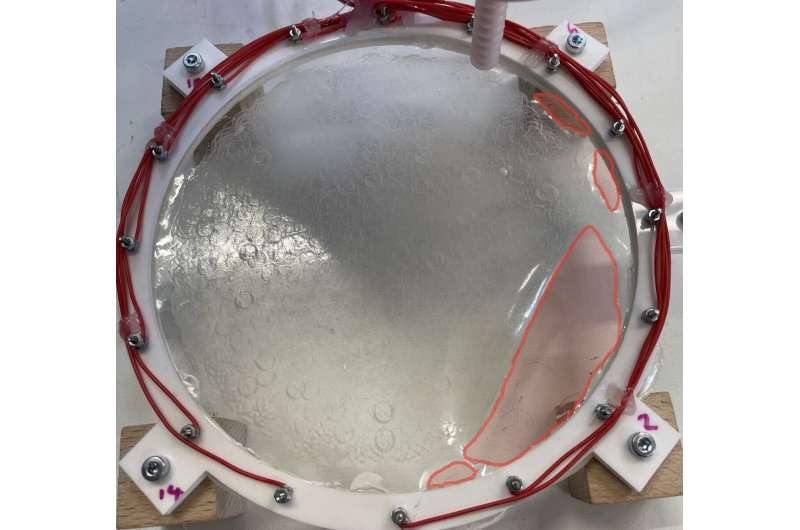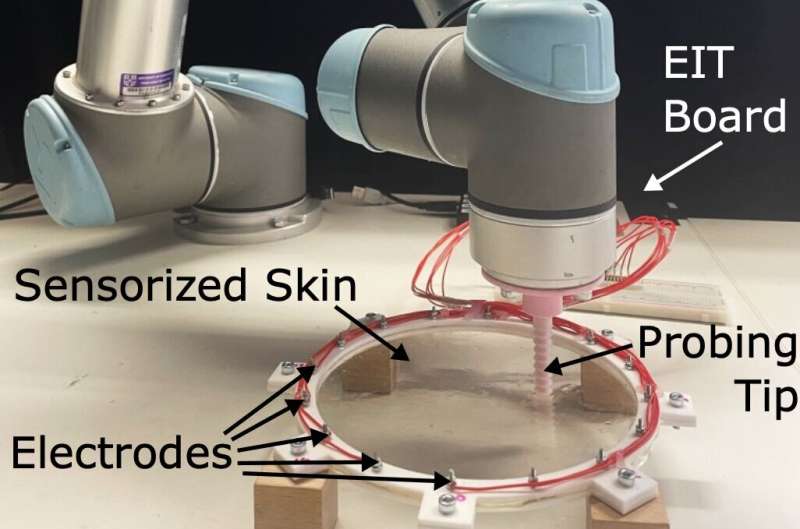The hydrogel-based skin created by the researchers, damaged during damage detection experiments. Credit: Hardman, Thuruthel and Iida.
For decades, roboticists have been trying to develop robots that closely resemble humans, both in terms of their appearance and capabilities. Recent technological advances have opened exciting new possibilities for the creation of human-like robotic systems, for instance by introducing more advanced sensors and soft artificial skins.
Researchers at the University of Cambridge's Bio-Inspired Robotics Lab recently created a new hydrogel-based skin that could allow robots to detect the tactile properties of objects, artificially reproducing the human sense of touch. This highly stretchable skin, introduced in a paper published in Materials Today Electronics, reconstructs tactile stimuli using a series of electrodes and a model-free computational approach.
"Recently, researchers all over the world have been interested in how robots can be manufactured from flexible and stretchable materials," David Hardman, one of the researchers who carried out the study, told TechXplore. "These 'soft' robots are safer to work with, don't damage the items they interact with, and can complete tasks which are very difficult for traditional 'rigid' robots. However, for the full benefits, all of a robot's components must be soft, including any sensors."
Drawing inspiration from human skin, Hardman and his colleagues set out to create a stretchable sensing material that could detect any damage, sense objects or a human's touch and monitor its surrounding environment. The artificial skin they created is based on a hydrogel (i.e., a water-insoluble gel that also contains water inside it) coupled with an electrode-based hardware system.
"We use a specially developed sensorized hydrogel as the basis of our skin, since this is biodegradable, customizable, and very stretchable," Hardman explained. "We couple this with Electrical Impedance Tomography (EIT) hardware, which uses electrodes at the edge of the skin to apply currents and measure voltages which give us information about the state of the skin. Using these voltages, we try to deduce where the skin has been touched, or whether it has been damaged."
The team's experimental setup. A sensorized hydrogel skin was probed by a robotic arm, whilst a series of measurements were collected using electrodes positioned around its perimeter. Credit: Hardman, Thuruthel and Iida.
Instead of analyzing the data gathered by electrodes using a conventional neural network-based architecture, as most existing artificial skins do, Hardman and his colleagues created deformation maps for their hydrogel-based system using a small amount of real-world data. In initial evaluations, they found that their system significantly outperformed an artificial skin system based on conventional neural networks, achieving an average resolution of 12.1 mm over a 170 mm circular skin.
"Combining electrical impedance tomography technologies with functional sensorised skins results in a set of problems which are very hard to solve using purely mathematical approaches," Hardman said. "We have presented a way of vastly simplifying this by including a small amount of real-world data into our calculations. Because of this, we can start to tackle applications which would be unthinkable using an analytical approach, adding soft tactile sensors over the entire surface of our robots."
So far, Hardman and his colleagues have tested the potential of their hydrogel-based skin for three key real-world applications, namely the detection or localization of damages, monitoring the environment and recognizing different tactile stimuli. Their system performed well in all of these three tasks, suggesting that it could be used to enhance the capabilities of soft robotic systems designed to tackle different missions.
"We are currently working on improving the shape and size of the skins so that they can be used to sense much more complex stimuli," Hardman added. "For example, if the skin were applied onto a robotic hand we would like it to sense not only the location and force of touches to the skin, but also the position of each finger and whether the hand has been damaged."
More information: David Hardman et al, Tactile perception in hydrogel-based robotic skins using data-driven electrical impedance tomography, Materials Today Electronics (2023). DOI: 10.1016/j.mtelec.2023.100032
© 2023 Science X Network

























